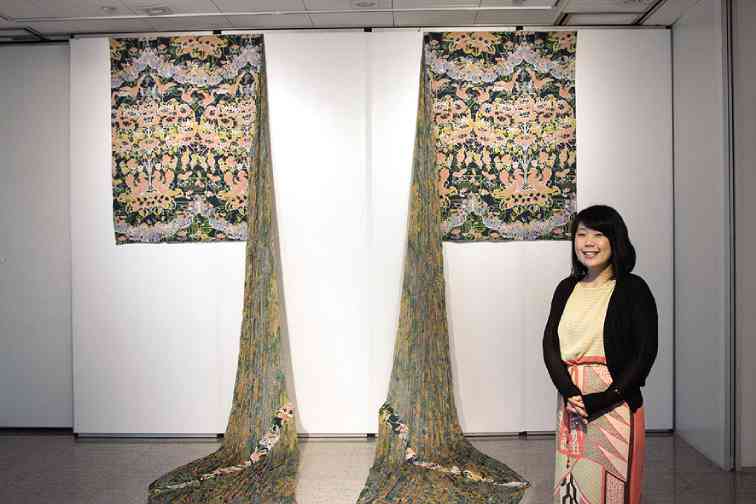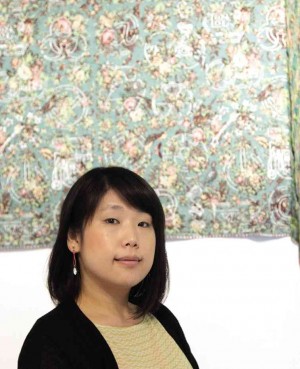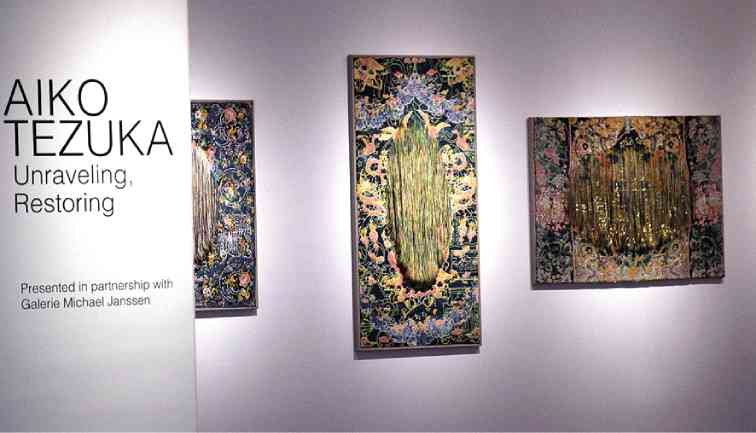
those from her “Certainty/Entropy” series can dominate a room. PHOTOSBY ALEXISCORPUZ
Comparing an artist’s chosen form of expression with that artist’s life can easily become a cliché. But in the case of Japanese textile artist Aiko Tezuka, such a comparison seems both fateful and necessary.
Tezuka does something both counterintuitive and revolutionary. She takes existing fabric (whether designed by her or someone else) and then she literally unravels the threads—taking care never to break them—and uncovers some new shape or insight in the fabric.
The fabric—and resulting exhibition piece—can be as big as a wall or as small as a book. The result is layers of design and meaning.
Filipinos can view Tezuka’s work for the first time with the exhibit “Aiko Tezuka: Unraveling, Restoring,” which runs at Ayala Museum’s third floor Exhibition Hall until July 19; the exhibit is offered in partnership with Singapore’s Galerie Michael Janssen.
Tezuka had held an exhibit in Singapore through Jansen, and she brought her exhibit to Manila through Jansen’s relationship with Ayala Museum.
“If I could show my art in new places, that’s always a happy thing for me,” Tezuka tells the Inquirer.
Integrity of threads
Growing up in Tokyo, Tezuka, like many Japanese children, was enamored of cartoons and manga; she shares a surname with the late great manga creator Osamu Tezuka but is not related to him.
“My parents sent me to art university instead,” she recalls in her excellent, accented English. “It was more realistic.”
 Tezuka took up Painting for her bachelor’s and master’s degree at Musashino Art University and studied as well as taught painting in Kyoto.
Tezuka took up Painting for her bachelor’s and master’s degree at Musashino Art University and studied as well as taught painting in Kyoto.
“Everything was painting,” she says.
It was then she made a decision that changed her life. “I didn’t get any special education for textile.”
In search of a form of expression all her own, Tezuka found fabric.
“Painting consists of pigments and canvass and it’s already fixed. I couldn’t be interested in that,” she explains. “But if I use more soft material, literally, like embroidery or stitching, I could deconstruct the surface.”
She taught herself the unraveling method that became her staple. She seeks to maintain the integrity of the woven threads without cutting them.
“As it was, as it is,” Tezuka says. “My basic theme is to deconstruct and to reconstruct something. I’m always thinking of focusing on what to remake or renew or reconstruct. What for? How? To make a new structure from the untied threads.”
Since then, she exhibited all over the world. She has relocated to Berlin, where she works with her assistant at a glacial pace.
Woven history
When unraveling the threads, Tezuka takes an excruciating amount of time, estimating it takes an hour to unravel just 10-15 centimeters of thread.

Tezuka takes fabric and then unravels it
to make something
new without cutting the
threads.
“If I practiced more, I’d be faster,” she admits, adding that attending to the real world eats into her creative time.
She travels to Tilburg, Holland, where her special fabric is made.
“We could say history is woven in front of us from the fabric. It’s not intentional but the fabric holds history already,” she says.
The space between the delicate threads seem impossibly small, but in Tezuka’s hands, they stretch wide as worlds.
The large installation 2014 series titled “Certainty/Entropy,” employs fabric of her own design for the first time. The original fabric combines 8th-century Japanese designs of the temples in Nara with modern symbols such as credit-card logos, biohazard warnings, peace signs and check marks.
“Everything is designed or created by human beings, yet so many things are in conflict,” she notes.
Tezuka mentions being fascinated by her study of Singaporean fabric, because of its mix of English/Irish design with Asian motifs such as pineapples and dragonflies. She’s looking forward to seeing Philippine textile designs and may add these to her arsenal of Old World/New World balance.
“Definitely,” she says. “I am always interested in textile from all over the world. It is my method to create my work by choosing and mixing up what I see in contemporary fabric.”
Less pressure
Living in Europe helps her because there, Tezuka feels less pressure. Art is a professional thing in Japan, but in Europe, it is more a shared passion: “In Japan, I feel like I must not fail, a narrow view, but in Europe, it’s okay when I make a mistake. I can play.”
“For the future, I always have many plans for future work but only less than ten percent of that can be realized,” she says. “Because if I do exhibitions, I, as the artist, have lots of things to do with the installations.”
It’s already been a busy year for Tezuka, who has already exhibited in Norway and Munich before the Ayala Museum exhibition. After Manila, she will exhibit twice more in her native Japan.

Though she has stretched away from her past into her present, the threads of her life remain uncut—and woven into new directions.
She has brought new, never-before-seen work to her Manila show: three smaller pieces called “Lessons for Restoration Binoculars 1,” “Lessons for Restoration Binoculars 2” and “Lessons for Restoration Vase.” She bought these wall hangings in Florence and then proceeded to unravel them, finishing in May just in time to bring them to Manila.
Through the reshaped threads, Tezuka hopes people will find something profound and personal.
“I want them to feel time,” she says. “Of course, time cannot be reversed anymore because time goes forward only and we cannot go back to the past. Even if we regret something, we cannot reverse it. To imagine it is impossible.”
All this is Aiko Tezuka’s only chance to reverse time. It is about possibility and opportunity. “If I didn’t choose to come to Manila, I could be in Berlin or somewhere else. I chose already and I cannot be in two places at once. We have to choose only once.”
“Aiko Tezuka: Unraveling, Restoring” runs until July 19 at 3/F Exhibition Hall, Ayala Museum, Makati City. For inquiries, call 7598288 or e-mail [email protected].








































